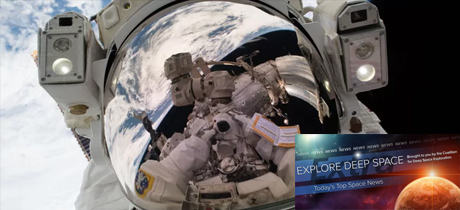In Today’s Deep Space Extra… NASA astronauts are to spacewalk outside the International Space Station today. Careful scientific and political support has enabled the U.S. to robotically explore much of the solar system. NASA readies TESS, a new mission to identify extra solar planets around the nearest stars.
Human Space Exploration
Watch live: NASA astronauts to install antennas during spacewalk
UPI (3/29): International Space Station newcomer astronauts Drew Feustel and Ricky Arnold, both of NASA, are embarking on a 6 1/2 hour spacewalk this morning to install a new set of wireless communications antennas and external cameras. Russia’s Soyuz MS-08 docked last Friday, delivering Feustel and Arnold and cosmonaut Oleg Artemyev for a six to seven month stay.
Space Science
NASA’s golden age? We’re in it [Opinion]
Planetary Society via Houston Chronicle (3/28): “We’ve answered lots of questions about our own planet by studying others,” emphasizes an op-ed that examines current and past U.S. and international efforts to explore the solar system with robotic spacecraft as well as their political and scientific support. The nation’s human space exploration effort, in contrast, has been tugged back and forth, largely at the whim of succeeding presidents, writes Emily Lakdawalla, of the Planetary Society.
NASA’s next planet hunter will launch a ‘new era of exoplanet research’
Space.com (3/28): Targeted for an April 16 lift off from Cape Canaveral Air Force Station, Florida, NASA’s Transiting Exoplanet Survey Satellite (TESS) mission is poised to search for the closest extra solar planets in the Milky Way Galaxy. Anticipated discoveries will become targets for space and ground based telescopes equipped to study their atmospheres and determine whether they are Earth-like and/or possess atmospheric biomarkers — or signs or biological activity.
WFIRST work continues despite budget and schedule uncertainty
Space News (3/28): A year’s delay in the launch of the James Webb Space Telescope (JWST) announced earlier this week is raising the concerns over the future of other complex astrophysics missions, like the Wide Field Infrared Space Telescope (WFIRST) slated to launch in the mid-2020s but facing cancellation as part of the White House 2019 budget proposal for NASA. NASA has scaled WFIRST back and is proceeding with efforts to carry out the project.
Europa lander concept redesigned to lower cost and complexity
Space News (3/29): NASA’s Jet Propulsion Laboratory has redesigned its concept for a Europa lander, a spacecraft that could land on the ice and ocean covered moon of Jupiter. The redesign is intended to reduce the cost of a mission below $3 billion. Like Mars, Europa may have habitable environments. A launch no earlier than 2020 is envisioned using NASA’s Space Launch System (SLS). The long flight would require five years. NASA has been focused instead on a Europa flyby mission, the Europa Clipper, as the next step in the exploration of the intriguing moon. Some in Congress, however, are eager to follow Clipper with a lander.
‘Mars quakes’ could shake up planetary science
Coalition Member in the News – Lockheed Martin
NASA/ Jet Propulsion Laboratory (3/28): NASA’s Mars InSight mission, scheduled to launch May 5 will attempt something no previous mission has done, assess the interior of the Red Planet with subsurface sensors that can detect Mars quakes, meteor strikes and other geophysical activities. InSight, assembled by Lockheed Martin, should reach the Red Planet in late November.
Rare galaxy found without any dark matter
Verge (3/28): No one knows what “dark matter,” which comprises an estimated 27 percent of the universe, is made of. Astronomers have identified a distant galaxy which seems to lack any “dark matter,” opening a mystery. Dark matter’s existence is attributed to the manner in which its mass influences the motion of star systems. Results of a Yale University led study were published in the journal Nature.
Other News
Undergrad science experiments launch on a NASA sounding rocket
Space.com (3/28): A Terrier sounding rocket launched from NASA’s Wallops Island Flight Facility early March 25 with experiments provided by students from four universities. The mission was part of NASA’s Undergraduate Student Instrument Project, a STEM initiative.

